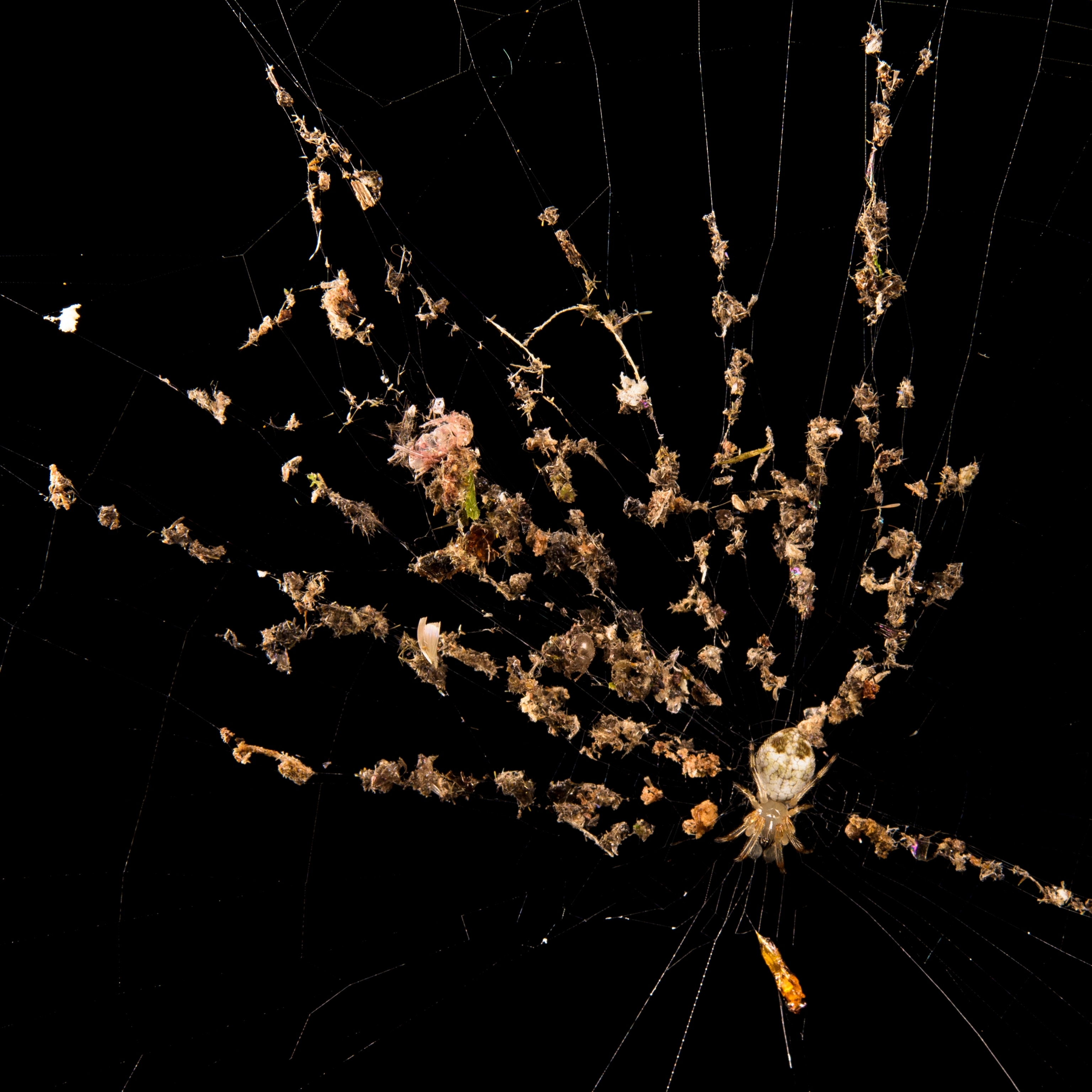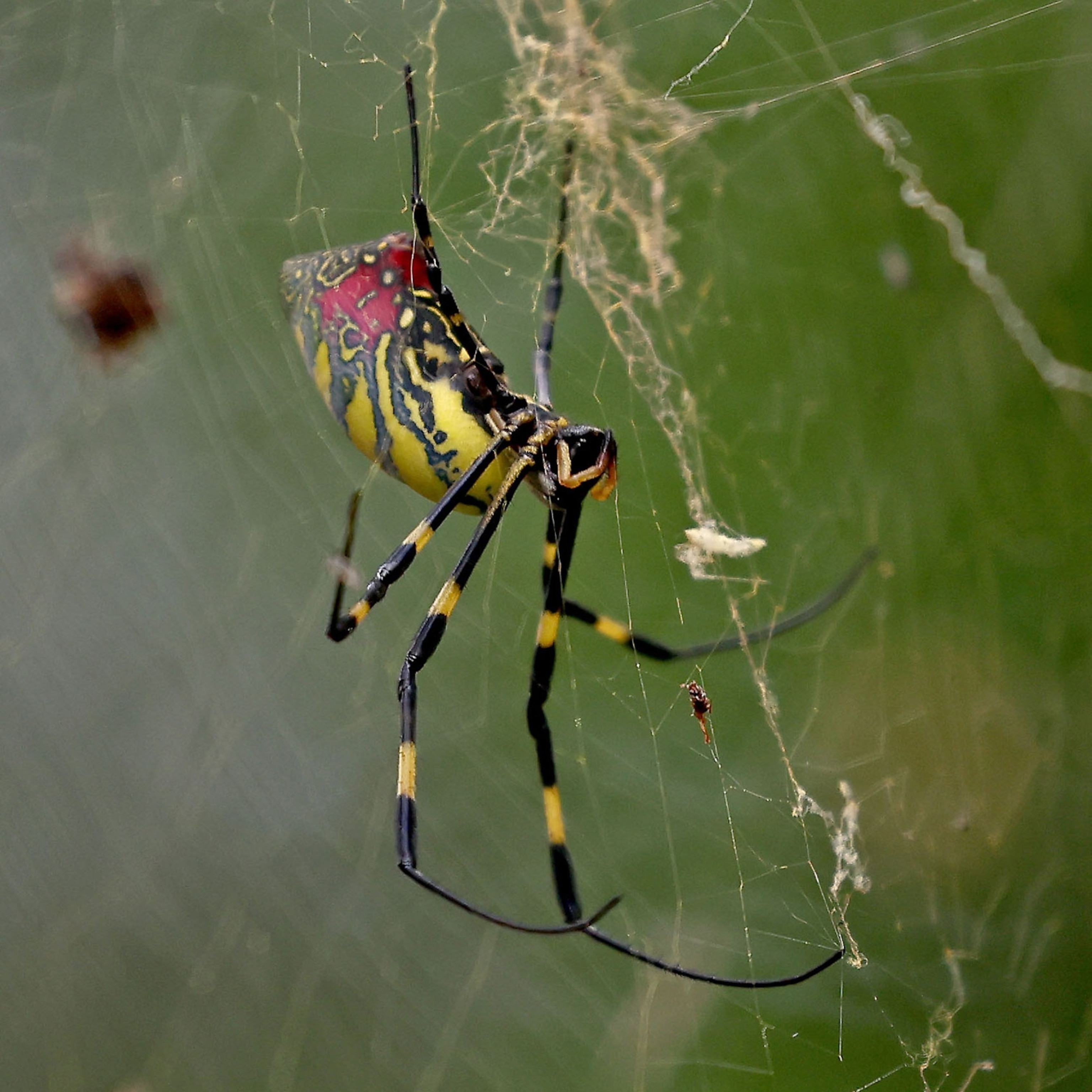This spider web is strong enough for a bird to sit on, a scientific first
The newly recorded behavior could mean the jorō spider, an invasive species, can provide a small but positive benefit to other wildlife.

On September 13, 2022, Atlanta-based naturalist and garden expert Arty Schronce looked out his kitchen window and saw what he thought was a female cardinal trapped in a huge, golden spiderweb.
That would have been strange enough—but upon closer inspection, Schronce realized that the bird wasn’t stuck after all. It actually was perched on a strand of the web and taking swipes at the large black, yellow, and red arachnid that built it: an invasive jorō spider (Trichonephila clavata).
After the spider was scared off, the cardinal gobbled up a few of the insects that had become caught in the web. Then it flew away.
(Why This Spider Has a Cartoonish Butt)
The whole encounter lasted just two minutes, but Schronce suspected he’d just witnessed something special. When he checked the next day, the spider was still there, and the web remained undamaged.
“This is incredibly unusual,” says Andy Davis, an expert on jorō spiders at the University of Georgia.
Birds stealing food out of spiderwebs is a documented behavior—but in previous instances, the birds were recorded as doing so while hovering or perched on a nearby branch, Davis and Schronce report today in a study published by the journal Insects. There are also records of birds sometimes becoming trapped in spider webs, or gathering spider webs to use in their nests. However, no one has ever reported a bird actively sitting on a spider’s web before.
(Spiderwebs Blanket Countryside After Australian Floods (Pictures))

“To the best of our knowledge, this is a scientific first,” Davis says. Schronce says that the experience has made him realize how important citizen scientists can be: “We can all observe and learn and maybe see something that has never been recorded before,” he says. As a longtime photographer, Schronce just wishes he’d had a better camera within reach.
Webs of a different color
The brightly colored jorō is thought to have been accidentally introduced to the United States in 2014 via a shipping container from East Asia, where the species is native. While mostly harmless to humans, the black, yellow, and red arachnids are large, with leg-spans as wide as an adult’s hand.
(Read about how scientists believe the jorō spider could spread throughout the eastern United States.)
What’s more, the jorō comes from a genus of orb-weavers well known for spinning large, tough webs. Another species in this genus, which has also been introduced to the Unites States, is known as the golden silk spider for the yellow-ish hue of its silk.
Coincidentally, only a few months before Schronce observed the bird perched in the jorō web, Davis had performed a series of tests to determine the spiderwebs’ strength as part of an elementary school science fair project with his son, Oscar.
The father-and-son duo used a fine thread to loop an electronic force gauge over the top of 10 jorō webs of similar size. They then pulled down gently until the webs broke under the strain, and recorded the force required in Newtons (a unit of measure defined as the force needed to accelerate one kilogram of mass at the rate of one meter per second every second).
The measurements the Davises took found that the jorō webs could hold an object weighing up to 2.4 ounces (69 grams). That means one should easily support a cardinal, a bird that typically weighs between 1.48 and 1.72 ounces (42 and 49 grams).
(Learn why scientists say spider silk is one of the most versatile materials on Earth.)
“Four or five months later, this guy calls me and says he's found a bird sitting on a web,” Davis recalls. “And then I kind of put two and two together and realized that I had data that basically showed the same thing.”
Oscar won the science fair—and Davis gained valuable support for the new finding.
'A pretty bizarre thing for a cardinal to do'
Cardinal expert Daniel Baldassarre says he’s never seen one of these common North American birds do anything like this. For one thing, “cardinals are not small birds,” says Baldassarre, who is an ornithologist at the State University of New York at Oswego.
In addition, they’re not really a kind of bird that forages in such a delicate manner. Cardinals spend a lot of time hunting for food on the ground and are much less likely to do the kind of “tightrope walking” Baldassarre says is more common of birds that mostly forage in the forest canopy.
“They’re just kind of more awkward and kind of lumbering in the way they forage,” he says.
At the same time, cardinals are known for exploratory behavior: “They do have this aspect of their biology where they will just try and eat anything, which is one of the reasons why they’re a very widespread, successful species,” he says.
So perhaps it’s not so surprising that the bird stole a few of the insects trapped in the spider’s web—a behavior known as kleptoparasitism.
“But yeah, it’s still a pretty bizarre thing for a cardinal to do,” Baldassarre says.
While so far the behavior has only been documented once, Davis wonders if more native birds might start to catch on to the potential benefits presented by these new, large spiders and their webs. Another native kleptoparasite known as the dewdrop spider already seems to making the most of the situation.
“These little spiders kind of make their living hanging out on other spider’s webs and stealing their food,” says Davis. “In all the jorō webs I’ve seen this fall, I’ve probably seen these dewdropspiders on at least 30 percent of them. So the dewdrops are benefiting big time from the jorōs.”








